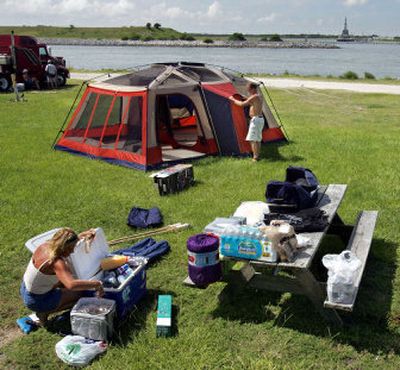Shuttle program’s future debated

KENNEDY SPACE CENTER, Fla. – As Discovery stands on the launch pad poised to take off today on the first shuttle flight since the destruction of Columbia 2 1/2 years ago, a debate is raging over how much longer America’s workhorse of space can struggle on.
National Aeronautics and Space Administration Administrator Michael Griffin has vowed to end the star-crossed program by 2010, saying the spacecraft has labored long enough. He is setting the space agency’s future on a next-generation shuttle, known as the Crew Exploration Vehicle, that won’t be operational before the current fleet retires.
That plan could create a gap of several years when the U.S. would not be capable of space flight, while Russia and China would continue flying.
Some scientists and congressional supporters of the shuttle say pushing the craft into retirement would be an unacceptable blow to American research and prestige. But others caution that extending the service life of the three remaining shuttles without major investments and upgrades would raise serious safety issues.
Sen. Kay Bailey Hutchinson, R-Texas, chairwoman of the Senate science and space subcommittee, said: “The possibility of a gap in space flight must be eliminated if the U.S. wants to be a leader in space exploration.”
Hutchinson inserted language in a NASA bill pending in the Senate that would forbid NASA from retiring the shuttle before a replacement is completed. A spokesman for Hutchinson said there is broad opposition among both Republicans and Democrats in the Senate to any proposal for an early retirement of the shuttle.
“There will be enormous pressure to keep it flying,” said Sheila Widnall, an aerospace professor at Massachusetts Institute of Technology and a member of the Columbia Accident Investigation Board. “I would not be in favor of flying the shuttle indefinitely. But I was disappointed when NASA said they were going to retire it.”
Widnall said NASA should recertify the shuttle’s safety systems in 2010, a plan laid out by Columbia investigators, while it develops the Crew Exploration Vehicle.
Other experts cite a host of major problems with retiring the shuttle in five years. First, it would cause a major loss of prestige to the United States to lack manned access to space, while both Russia and China have the capability.
A long lapse in launches would erode the skilled work force that exists at the Kennedy Space Center, as well as other key aerospace centers across the nation. Finally, the shuttle is critical to using the full capability of the International Space Station.
“If we take the shuttle offline, the space station becomes a lot less useful,” said Norman Thagard, a former astronaut and engineering professor at Florida State University. “The space shuttle and the space station go hand in hand.”
NASA currently plans up to 28 more missions over the next five years to complete the International Space Station.
Griffin would prefer that the shuttle fly even less. Since taking over NASA in April, Griffin ordered a 60-day review of the future of the human space program. A spokesman said he is considering reducing the flights to a range of 16 to 24, just enough to finish construction of the space station.
“I am working very hard to develop a program that replaces the shuttle with a new vehicle,” Griffin said at a news conference Tuesday at Kennedy Space Center. “By the time it retires, it will have been in service for 30 years. That is enough.”
Some outside experts say that it would be a mistake to extend the life of the three remaining shuttles without making far more extensive safety improvements.
NASA has spent the past 29 months undertaking a massive effort to fix the specific problems with debris that caused the Columbia shuttle accident in 2003, but it has deferred some potentially critical safety and operational issues.
Though experts are confident that the agency has fixed the immediate problem of foam and other debris that could damage the orbiter during launch, they say the agency has not made investments needed to modernize and upgrade many other key shuttle systems.
“If you are going to fly humans over the next 10 to 15 years, you are not going to do it with anything but the shuttle,” said Richard Blomberg, former chairman of NASA’s outside safety advisory panel. “If we are going to fly the shuttle, we should improve it.”